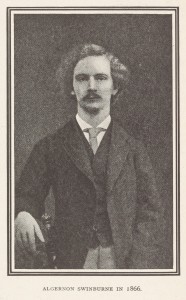Poems and Ballads at 150

A portrait photograph of Swinburne, from Thomas James Wise’s bibliography of the poet’s writings, 1919. 859.c.53
This summer marks the 150th anniversary of the publication of Algernon Charles Swinburne’s Poems and Ballads (1866) which appalled Victorian readers with its anti-authoritarianism, republicanism and anti-theism, its themes of sado-masochism, homoeroticism and necrophilia. This literary event—along with the earlier exhibitions of Pre-Raphaelite art—furthered a debate about the connection between style and morality which would come into sharper focus during Oscar Wilde’s trial in 1895. The publication of Poems and Ballads and its subsequent withdrawal and republication by a publisher with a dubious reputation (he also dealt in pornography) presents an intriguing glimpse into the world of poetry publishers and readers of poetry in the mid-nineteenth century and the culture of reviews and reputation in literary London.
Yet the collection was also dazzling for its lyricism, mastering metrical and poetic forms from across European and Classical poetry, even inventing new forms. While the content was sure to secure its author’s ill repute during his lifetime, Swinburne’s influence on subsequent generations of poets was lasting: T.S. Eliot would later recall that ‘the question’ on every aspiring poet’s lips in 1920 ‘was still where do we go from Swinburne, and the answer appeared to be: nowhere.’ The modernist, H.D., wrote that ‘we are the children of Swinburne’, while Dylan Thomas could still refer to poetic composition as his ‘tame Swinburne machine’ in 1941.
The exhibition ‘Poems and Ballads at 150’, which will be on view in the display cases in the Library’s North Front Corridor between 20 July and 13 August, sets out to tell the story of the publication, withdrawal and re-publication of Poems and Ballads, beginning with the publication of the poem ‘Faustine’ in The Spectator in 1862—which did not strike the editor as obscene at the time—through to the role the book played in the disqualification of Swinburne for the Poet Laureateship after the death of Alfred Lord Tennyson in 1892.
The exhibition includes reactions to and defences of the book by reviewers, including William Michael Rossetti (brother to Christina and Dante Gabriel) and Swinburne himself. It presents a rare opportunity to see the original Moxon edition as published previous to its withdrawal, alongside the book as it was republished by Hotten, with other books issued by both publishing houses. Also on show is the second edition of Charles Baudelaire’s Les Fleurs du Mal, reviewed by Swinburne in 1862, which introduced the French poet—whose poems famously incurred legal action—to English readers, and a letter in which the Prime Minister W. E. Gladstone, faced with the vacant laureateship on the death of Tennyson, makes his opinion of Poems and Ballads very clear.
This exhibition accompanies the conference celebrating 150 years of Poems and Ballads, which will be held at St John’s College, Cambridge, 29-30 July 2016. For more information, please see the conference website or contact the convenors at poemsandballadsat150 [@] gmail.com.
Laura McCormick Kilbride and Clive Simmonds
